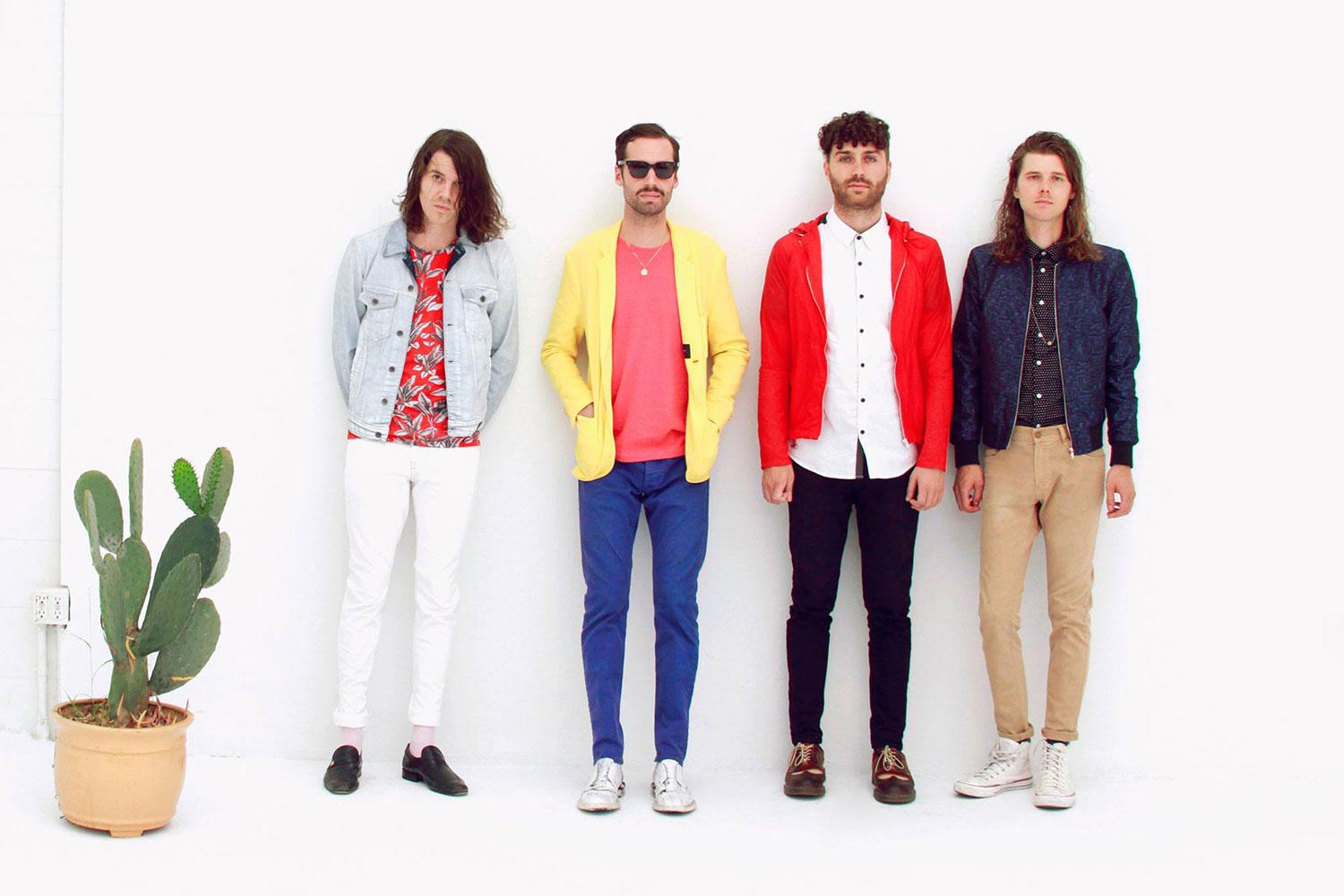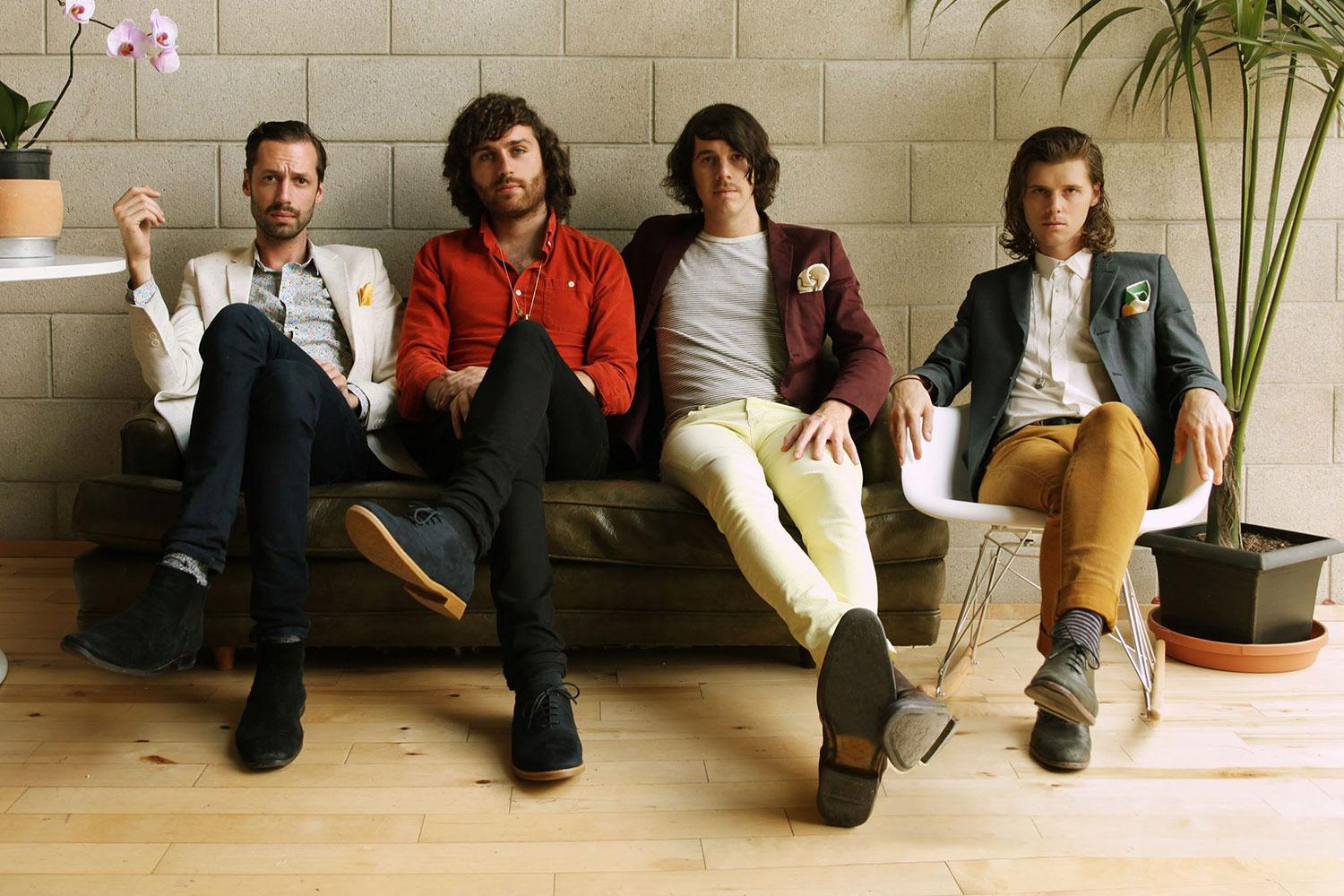The phrase “Miami Horror” instantly evokes a clash of two worlds, juxtaposing something that’s sunny and sexy with a feeling of primal dread. Actually, Miami Horror is the electronic quartet that’s the brainchild of Melbourne, Australia expat Benjamin Plant, a DJ who’s done remixes for the likes of Bloc Party, Tegan and Sara, and Faker. Miami Horror’s 2010 debut, Illumination, planted an indelible nu-disco flag on the scene — you probably remember the über-bubbly Sometimes pop-pop-popping up in the soundtrack of Grand Theft Auto V. But it took Plant and company a few good years to wrap its follow-up, the luminous All Possible Futures, out now in various formats from Haven Sounds/Dine Alone Records. “I tried not to ‘perfect’ it as much this time, but we had to try every direction we wanted,” explains Plant about the two-and-a-half years it took to complete Futures. “We covered, ironically — or may not ironically — all the possible ways we could have gone with the album, but yeah, now I’m happy with it.”
The wait was totally worth it. The ever-so-aptly named All Possible Futures is a post-disco dreamfest, moving from the airy promise of opener American Dream, to the swirling seduction of Real Slow, to the Nile Rodgersesque jangly singalong of Wild Motion. Digital Trends got on the horn with Plant to discuss the art of the album format and understanding song structure, consciously going lo-fi in the high-res age, and choosing a royal dream collaborator. Set it free, let it go.
Digital Trends: Did you have overall sonic goals for this album once you got down to it?
Benjamin Plant: Yeah, there were a few. And that’s generally where we have “the problem” — we have too many ideas and options. But we managed to pull it all together into, I guess you could say, one sliding scale — upbeat and funky all the way through to down-tempo dreamy. Then we colored everything in between.
That’s a great description. It’s hard for me to decide on my favorite track. Some days, it’s Love Like Mine, and others, it’s either Colours in the Sky or All It Ever Was. It seems to change with every listen.
(chuckles) That’s the thing — we like to make albums where you can’t pinpoint your favorite for too long. To me, the ultimate album is making something for the listener to progress where, maybe in five years, you get something different from it, since you’ve grown up a little bit more in between that time.

One thing I feel is that most people’s albums are a lot more consistent than ours, whether it be old albums or new albums. I think albums grow on people, but I can’t think of any albums that have an influence on me like that. I think of an original thought, without basing it on anything. There are many technical aspects to the artform of making an album, and what I’d ask is while you don’t have to listen to it in order every time, do it every now and then.
I always feel like I should respect the order of an album that an artist has presented to me as a listener. Some records you really need to spend a good bit of time with to absorb properly.
Yes. And that’s kind of what I was talking about a little bit. We attempted to do less-simple songs, even though they’re generally pop-structured. When we wrote the first album [Illumination], we just kind of winged it. It wasn’t until we got to the last few songs where I was actually trying to make verses and choruses and understanding where bridges go.

This album was an exploration of how to actually write a song in a classic sense. The result of that is sometimes you have a lot more parts, so it takes time for you to understand every song — as opposed to a song that has only one chord progression for 3 minutes, where you can listen to it and it sounds almost instinctual. These songs are not as instinctual or simple. You really have to hear them a few times for you to completely love them, I think.
It really does keep growing on you with every listen. What gear did you use to record All Possible Futures?
We tried to keep it simple, with just a few synths, guitar, and bass. Nothing crazy, but we used a lot of interesting plug-ins that people don’t normally use, I guess. Because we were moving a lot, we didn’t have a completely set-up studio. [Futures was recorded in a number of locations — California, Australia, and Paris.] For this album, it was a blessing just to have everything plugged in at once! We had to learn to work and innovate with a lot of plug-ins, and we mastered that. We used new technology to learn new things, without sounding like everyone else who’s doing it.
“We went for a more Talking Heads, post-disco Tom Tom Club, Michael Jackson vibe.”
There was a lot of focus on replicating analog delays, speaker boxes, and things like that — using a lot of plug-ins to grade the sound or warp it a little bit so that it sounds wonky, to give it a little bit more of a lo-fi feel. And then, obviously, we recorded a lot of percussion for tracks like Love Like Mine, Out of Sight, and Wild Motion. We went for a more Talking Heads, post-disco Tom Tom Club, Michael Jackson vibe. The tracks were all a lot more loose, and less programmed. There was a lot of live guitar, and percussion-wise, we used everything from glasses to roto-toms, cowbells, and woodblocks. That’s something we definitely expanded on, since the first album was mostly programmed.
I think there’s definite progression here. Illumination had the building blocks that you took to another, post-disco dimension on Futures.
Firstly, this album was a big jump for us in terms of learning songwriting. From there, we could start to break the rules. Whereas with the first album, we were accidentally breaking the rules because we didn’t know what we were doing. Once you learn all the rules, you learn how to do them in a more interesting way. You learn that you don’t always have to have a pre-chorus or a post-chorus, so we went really hard in that direction for this album. I think with that knowledge, for the next album, we can let things happen more naturally.
I love that you got into a Talking Heads vibe here. I want to say it reminds me a bit of Remain in Light (1980), but it’s beyond that since you also have that Tom Tom Club feel. I guess we’ll have to call it something like Talking Club.
(chuckles) It’s definitely influenced by Remain in Light, but a little bit more poppy. Out of Sight is a good example where we were trying to do the Talking Heads-influence thing, and that was one of our big “pains” for the album. But we felt we hit home with that one.
You mentioned going for a lo-fi feel. Did you record at 96, 88, or 44.1? Was going high-resolution not something you were concerned with?
We just recorded at 44.1, I think. Going into this album, we didn’t want to worry about things like that. I don’t think there would be an audible difference if we had recorded at a higher resolution. The only problem if we had would be that we would have had more crashes, and it would have taken more time to load things up. Since we were going for a slightly lo-fi sound, it kind of benefited us to not worry about those things too much and focus on building the actual sounds we were using, the songwriting, and stuff like that.
Speaking of lo-fi, is that surface noise I’m hearing at the outset of Cellophane (So Cruel)?
You mean the crackling? There is a little bit of that in there, yeah. There’s a vocal sample that’s taken from vinyl, so we just kept that in there.
I like hearing surface noise sometimes. Are you a fan of vinyl yourself?
Yeah, I’ve been mainly collecting it since I’ve been here in the States, as opposed to Australia. It’s a lot easier to collect here for sure.
Do you remember the first album you got growing up in Australia?
“I don’t think there would be an audible difference if we had recorded at a higher resolution.”
When I was really young as a kid, I was listening to my parents’ records. I didn’t really like pop music at the time. I was into music when I was 7 or so. When you’re getting pushed more into the pop world and what went up the charts, I just wasn’t into it, until I got into alternative music in my teenage years; then I got back into it. Probably one of the first albums I bought around that age was The Strokes, Is This It? (2001). I listened to a lot worse music than that when I was 14, so at least I can say it was that album. (chuckles)
The Strokes are never a bad place to start. I see you’re going out on the road, starting in May. Is there anything you feel you have to do differently onstage to replicate this album the way you want us to hear it?
Well, I think it’s going to be really hard to reinterpret Cellophane since we don’t tour with those guest vocalists. The aim has always been on the recordings — to do what you have to do to get the recording right — but we’ve been playing the songs with other featured singers. It just generally sounds more live — closer to a rock band than a dance production.
I think All Possible Futures may become many people’s favorite summertime album. Does it feel like a summertime record to you?
That’s what people generally say. It comes out that way, for some reason. To me, there’s some melancholy to it, too — but only just a little bit. It’s interesting. Maybe even the name sets people up a bit for some kind of interpretation of summer.

Plus the bright cover art, and the convertible on it. Who would be your dream collaborator?
I mean, I could say I’d love to work with Prince, but who cares, really? So maybe I’ll say that. (chuckles)
Well, you never know with Prince — he could call you at 3 in the morning and say, “Come here now.” It seems he likes to work that way.
I know! I always wonder if that’s intentional. He probably just thinks it’s weird to be on a regular schedule. At least he has his vision and his way of thinking, and that’s how it goes.
“Vision” is a good word for it, because I felt you had a clear vision for how you wanted to present this new material.
I think vision is the most important thing overall. You can produce something really well, but if you don’t know what you want to do, you can’t really do anything.






